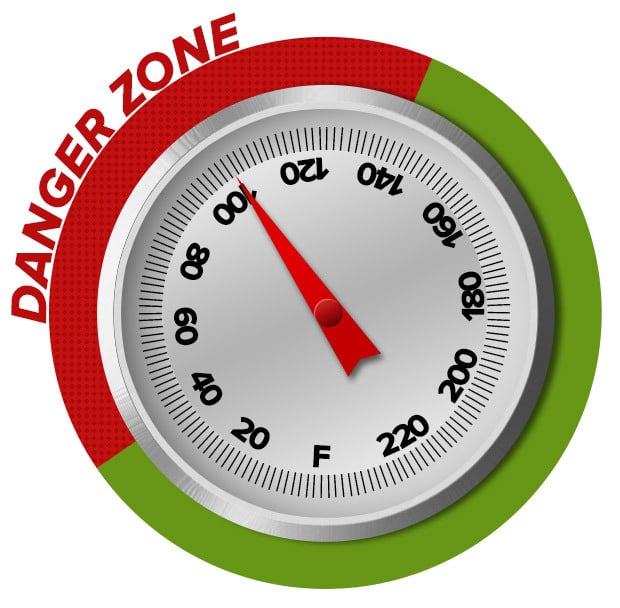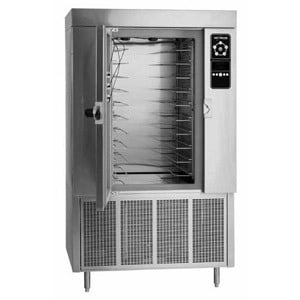What Is the Temperature Danger Zone?

The temperature danger zone is food temperatures between 41 and 135 degrees Fahrenheit, and the most rapid bacteria growth occurs between 70 and 125 degrees Fahrenheit. The longer food sits in this temperature range, the greater the risk that bacteria will begin to grow on your food.
As these bacteria reach unsafe levels, this can cause food to spoil and become dangerous for consumption. As a food service professional, it’s your responsibility to avoid these issues by ensuring food is quickly chilled or heated to food safe temperatures.
How Long Can Food Stay in the Temperature Danger Zone?
As a general rule, it is recommended foods enter their proper temperature zones within 2 hours. For cold foods, the food safe temperature is 40 degrees Fahrenheit and below. For hot foods, the safe temperature is above 140 degrees Fahrenheit.
Additionally, if you’re operating in a warm kitchen that’s above 90 degrees Fahrenheit, your food shouldn’t be in the danger zone for longer than an hour. The warmer temperature can help bacteria grow faster, making it more important for you to heat or chill it to safe temperatures quickly.
How to Keep Food Out of the Temperature Danger Zone
The easiest way to keep food out of the temperature danger zone is to take and monitor temperatures regularly. This is imperative not only while cooking your temperature control for safety (TCS) food, but it is also imperative when holding food on your buffet line or salad bar.
Follow these important tips to ensure you’re making the best use of your thermometer to keep food safe for consumption.
- Consistently monitor your refrigerator or freezer temperatures. You may want to use a secondary refrigerator or freezer thermometer, as the thermometer built into your appliance may not be accurate.
- Keep a written record including the temperature measured and the time it was taken.
- Clean and calibrate thermometers often.
- Regularly test employee’s knowledge of proper thermometer handling and use.
How Do You Rapidly Cool Hot Foods?
Many larger establishments prepare dishes ahead of time for maximum efficiency in their kitchen. When doing this, however, it’s imperative to know the best way to quickly cool food that won’t be served right away.
If you’re preparing food ahead of time, you must bring the temperature down below 41 degrees Fahrenheit within 2 hours of hitting its proper internal temperature.
Tips for Cooling Hot Foods to Food Safe Temperatures
Placing hot food directly into your refrigerator or freezer is never recommended because it endangers the food around it by raising the ambient temperature in your fridge or freezer. This creates the possibility of other foods in your refrigerator or freezer entering the temperature danger zone and developing bacteria without you even knowing. Instead, follow these tips for quickly cooling your hot foods.

- Use a commercial blast chiller to quickly cool foods while minimizing time food spends in the danger zone.
- Store foods in shallow containers to allow the temperature to distribute more evenly.
- Consider using a cooling paddle to reduce the temperature of hot liquids including soups, stews, and sauces, or lay it on top of warm casseroles to quickly bring foods below the danger zone.
- Create an ice bath by filling a pot, container, or sink basin with ice. Containers of hot foods can be placed in the ice bath to quickly cool food to food safe temperatures below 41 degrees Fahrenheit.
Hot and Cold Food Holding
Once your food is cooked to the proper internal temperature or chilled below 40 degrees Fahrenheit, it’s important to maintain these safe temperatures before serving. There are a number of instances in which food service professionals need to hold food for extended periods of times. These could include salad bars, buffet lines, transporting to off-site or satellite locations, and catering events.
When transporting food, it is recommended you use a food pan carrier or insulated catering bag to ensure your hot or cold foods remain safe for consumption.
How Cold Does a Salad Bar or Refrigerator Have to Be to Keep Food Safe?
Salad bars and refrigerators need to maintain temperatures below 41 degrees Fahrenheit to prevent the growth of dangerous bacteria. This is especially important as you house vulnerable TCS foods including cheese, yogurts, meats, salad dressings, and egg products.
How Often Should I Check the Temperature of Hot or Cold Holding Food?
It is recommended you check the temperature of your hot or cold holding food every four hours. However, if you check every 2 hours instead, this allows enough time to take corrective action in the event that food has fallen into the danger zone. By staying on top of your food’s internal temperatures, you can prevent the spread of dangerous bacteria and eliminate food waste by simply re-heating or re-chilling the affected foods before bacteria has time to spread.
How Do You Hold Hot Food?
Here are some tips to properly hold hot foods so they don’t fall into the danger zone:

- Hot holding equipment is typically not designed to reheat or bring food to temperatures out of the danger zone. Instead, it’s meant to hold already hot food at 140 degrees or higher.
- When possible, keep food covered to help maintain temperatures and keep contaminants out.
- Stir frequently to evenly distribute heat throughout the food.
- Use the appropriate thermometer to monitor food temperatures often.
- Discard food that has been sitting below 140 degrees for more than 2 hours.
- Never mix freshly prepared food with foods already being held for service to prevent cross contamination.
How Do You Hold Cold Food?
Here are some tips to properly hold cold foods so they don’t fall into the danger zone:
- Ensure your cold-holding equipment is designed to keep foods at 41 degrees Fahrenheit or lower.
- With the exception of fruits, vegetables, and molluscan shellfish, never place food directly on ice. This can cause bacteria to grow on the ice and create cross-contamination.
- Keep food covered to protect from contaminants.
- Cold food may be held without refrigeration for up to 6 hours starting from the time it was removed from refrigeration at a temperature below 41 degrees.
- Discard any cold food that reaches a temperature of 70 degrees Fahrenheit or higher.
Cold Food Storage
In addition to holding and serving cold foods, it’s important to know how long you can store cold foods before they become unsafe for consumption. Always date label your refrigerated foods and use a first-in, first-out (FIFO) system. Use this chart as a reminder of how long items can be safely kept before they must be discarded.
| FOOD ITEM | REFRIGERATOR (40°F) | FREEZER (0°F) |
|---|---|---|
| Bacon | 1 week | 1 month |
| Beverages | 3 weeks unopened, 7-10 days opened | 8-12 months |
| Cheese – hard (Swiss) | 3-4 weeks | 6 months |
| Cheese – soft (brie) | 1 week | 6 months |
| Chicken, egg, macaroni, and tuna salad | 3-4 days | Do not freeze |
| Cottage cheese | 1 week | Do not freeze |
| Dough – cookie | Use by date | 2 months |
| Dough – tube cans of rolls, biscuits, pizza dough | Use by date | Do not freeze |
| Egg substitutes – opened | 3 days | Do not freeze |
| Egg substitutes – unopened | 3 days | 1 year |
| Eggs – fresh in shell | 3-5 weeks | Do not freeze |
| Eggs – hard cooked | 1 week | Do not freeze |
| Fish – fatty (salmon) | 1-2 days | 2-3 months |
| Fish – lean (cod) | 1-2 days | 6 months |
| Ground meats – raw | 1-2 days | 3-4 months |
| Ham – fully cooked, slices | 3-4 days | 1-2 months |
| Ham – fully cooked, whole | 1 week | 1-2 months |
| Hot dogs – opened | 1 week | 1-2 months |
| Hot dogs – unopened | 2 weeks | 1-2 months |
| Luncheon meats – opened | 3-5 days | 1-2 months |
| Luncheon meats – unopened | 2 weeks | 1-2 months |
| Margarine | 4-5 months | 12 months |
| Mayonnaise – opened | 2 months | Do not freeze |
| Milk | 1 week | 3 months |
| Poultry – cooked | 3-4 days | 2-6 months |
| Poultry – fresh, chicken or turkey | 1-2 days | 6 months |
| Prepared leftovers | 3-4 days | 2-3 months |
| Sausage – raw | 1-2 days | 1-2 months |
| Sausage – cooked | 1 week | 1-2 months |
| Steaks, chops, and roasts – raw | 3-5 days | 4-6 months |
Safe Temperatures for Cooking Meat
To prevent the spread of salmonella, staphylococcus aureus, listeria, and other dangerous bacteria, it’s important to closely monitor the internal temperature of the meat you serve.
The U.S. Department of Health & Human Services (HHS) recommends the following meat and poultry temperatures to ensure food safety:
| CATEGORY | FOOD | TEMPERATURE | REST TIME |
|---|---|---|---|
| Ground Meat and Meat Mixtures | Beef, Pork, Veal, Lamb | 160° | None |
| Turkey, Chicken | 165° | None | |
| Fresh Beef, Veal, Lamb | Steak Roasts, Chops | 145° | 3 minutes |
| Poultry | Chicken & Turkey, Whole | 165° | None |
| Poultry Breasts, Roasts | 165° | None | |
| Poultry Thighs, Legs, Wings | 165° | None | |
| Duck & Goose | 165° | None | |
| Stuffing (Cooked Alone or in Bird) | 165° | None | |
| Pork and Ham | Fresh Pork | 145° | 3 minutes |
| Fresh Ham (Raw) | 145° | 3 minutes | |
| Precooked Ham (To Reheat) | 140° | None | |
| Eggs and Egg Dishes | Eggs | Cook until yolk and white are firm | None |
| Egg Dishes | 160° | None | |
| Leftovers and Casseroles | Leftovers | 165° | None |
| Casseroles | 165° | None | |
| Seafood | Fin Fish | 145°, or cook until flesh is opaque (no longer transparent) and easily separates with a fork | None |
| Shrimp, Lobster, and Crabs | Cook until flesh is pearly and opaque | None | |
| Clams, Oysters, and Mussels | Cook until shells open during cooking. | None | |
| Scallops | Cook until flesh is milky white or opaque and firm | None |
What Do You Need to Know About Resting Time for Meats?
Before taking temperatures, it’s important to note the rest time required when removing meat from the grill, oven, or other heat source. During this time, the temperature will remain consistent or continue to rise. This process helps to destroy harmful germs.
It’s every food service operator’s top priority to keep the food they’re serving safe for consumption. Following these important tips and guidelines will ensure your managers and staff have the knowledge to keep food out of the danger zone, take corrective action, and keep customers safe from harmful foods.